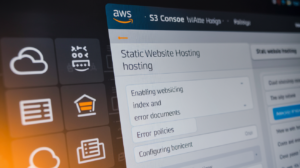Imagine deploying a critical update to your application, only to find your entire system crashing, leaving users frustrated and your team scrambling. 😱 Sounds like a nightmare, right? This scenario is all too familiar for many developers and operations teams. But what if there was a way to roll out updates seamlessly, without any downtime or user disruption?
Enter the world of zero downtime deployments. 🚀 These cutting-edge strategies – Blue-Green, Canary, and Rolling deployments – are revolutionizing how we update and maintain our systems. They promise not just continuous availability but also reduced risk and increased confidence in the deployment process. But how do they work, and which one is right for your project?
In this blog post, we’ll dive deep into the realm of zero downtime deployments. We’ll explore the ins and outs of Blue-Green, Canary, and Rolling deployment techniques, comparing their strengths and use cases. By the end, you’ll have a clear understanding of these strategies and be equipped to implement them in your own projects, ensuring your users never experience a moment of downtime again.
Understanding Zero Downtime Deployments
A. Definition and importance
Zero downtime deployments refer to the process of updating or releasing new versions of software applications without interrupting service availability for end-users. This approach is crucial in today’s fast-paced digital landscape, where continuous service availability is expected. By implementing zero downtime deployment strategies, organizations can maintain uninterrupted service while rolling out updates, bug fixes, or new features.
| Aspect | Traditional Deployment | Zero Downtime Deployment |
|---|---|---|
| Service Interruption | Yes | No |
| User Experience | Disrupted | Seamless |
| Deployment Frequency | Limited | Frequent |
| Risk of Data Loss | Higher | Lower |
B. Benefits for businesses and users
Zero downtime deployments offer numerous advantages for both businesses and users:
- Enhanced user experience
- Increased customer satisfaction
- Improved system reliability
- Reduced financial losses due to downtime
- Greater flexibility in deployment schedules
- Faster time-to-market for new features
- Minimized risk of data loss or corruption
C. Common challenges in implementation
While zero downtime deployments provide significant benefits, they also come with challenges:
- Complexity in architecture design
- Increased initial development time
- Need for robust testing and monitoring
- Database schema changes and data migration
- Compatibility issues between old and new versions
- Higher infrastructure costs
- Requirement for skilled DevOps personnel
Addressing these challenges requires careful planning, proper tooling, and a well-defined deployment strategy. As we explore various zero downtime deployment techniques in the following sections, we’ll see how different approaches can help overcome these obstacles and ensure smooth, uninterrupted service delivery.
Blue-Green Deployment Strategy
How it works
Blue-Green deployment is a strategy that uses two identical production environments, dubbed “Blue” and “Green.” Here’s how it operates:
-
Initial setup:
- Blue environment: Active, serving live traffic
- Green environment: Inactive, ready for updates
-
Deployment process:
- New version is deployed to the Green environment
- Testing and verification are performed on Green
- Once validated, traffic is switched from Blue to Green
- Green becomes the new active environment
-
Post-deployment:
- Blue environment is kept as a quick rollback option
- For the next update, roles are reversed
| Stage | Blue Environment | Green Environment |
|---|---|---|
| Pre-deployment | Active (Live) | Inactive |
| Deployment | Active (Live) | Updated & Tested |
| Post-deployment | Standby | Active (Live) |
Advantages of Blue-Green deployments
Blue-Green deployments offer several benefits:
- Zero downtime: Users experience no interruption during the switch
- Easy rollback: Quick reversion to the previous version if issues arise
- Reduced risk: Thorough testing in a production-like environment
- Simplified database schema changes: Allows for easier management of database migrations
Potential drawbacks
Despite its advantages, Blue-Green deployment has some challenges:
- Resource intensive: Requires maintaining two full production environments
- Cost implications: Doubled infrastructure costs during the transition period
- Data synchronization: Ensuring data consistency between environments can be complex
- Limited suitability: May not be ideal for all application types or architectures
Best practices for implementation
To maximize the benefits of Blue-Green deployments:
- Automate the process: Use CI/CD pipelines for consistent and reliable deployments
- Implement robust monitoring: Quickly detect and respond to issues in the new environment
- Plan for data migration: Develop strategies for handling data changes during the transition
- Conduct thorough testing: Perform comprehensive tests in the Green environment before switching
- Use feature flags: Gradually roll out new features to minimize risk
Now that we’ve explored Blue-Green deployment, let’s examine another popular strategy: Canary deployment.
Canary Deployment Technique
Concept and methodology
Canary deployment is a gradual release strategy that involves rolling out new features or updates to a small subset of users before full-scale deployment. This method, named after the practice of using canaries in coal mines to detect toxic gases, allows teams to test new versions in a real-world environment while minimizing risk.
The process typically involves:
- Deploying the new version to a small percentage of servers or users
- Monitoring performance and user feedback
- Gradually increasing the deployment percentage
- Rolling back if issues are detected or proceeding to full deployment if successful
Key benefits of Canary releases
Canary deployments offer several advantages:
| Benefit | Description |
|---|---|
| Risk Mitigation | Limits potential impact of bugs or issues to a small user base |
| Real-world Testing | Provides insights into actual user behavior and system performance |
| Flexible Rollout | Allows for easy adjustment of deployment speed based on feedback |
| Cost-effective | Reduces the need for extensive pre-production testing environments |
Risks and considerations
While canary deployments are powerful, they come with challenges:
- Complexity in managing multiple versions simultaneously
- Potential inconsistencies in user experience during partial rollout
- Need for robust monitoring and alerting systems
- Careful consideration of which metrics to track for decision-making
Tools for managing Canary deployments
Several tools can facilitate canary deployments:
- Spinnaker: Open-source, multi-cloud continuous delivery platform
- LaunchDarkly: Feature flag management service
- Istio: Service mesh for traffic management and observability
- AWS CodeDeploy: Automated deployment service with built-in canary support
These tools provide features like traffic splitting, automated rollbacks, and detailed metrics tracking, making canary deployments more manageable and effective.
Rolling Deployment Approach
Mechanism of Rolling updates
Rolling updates involve gradually replacing instances of the old version with the new version, ensuring continuous service availability. This process typically follows these steps:
- Start with the existing deployment
- Update a small subset of instances
- Verify the health of updated instances
- Continue updating remaining instances in batches
- Complete the rollout once all instances are updated
| Phase | Old Version | New Version |
|---|---|---|
| Start | 100% | 0% |
| Mid | 50% | 50% |
| End | 0% | 100% |
Advantages over traditional deployments
Rolling deployments offer several benefits:
- Minimal downtime
- Reduced risk of widespread failures
- Easy rollback capabilities
- Efficient resource utilization
- Gradual traffic shifting
Limitations and when to avoid
While rolling deployments are versatile, they have some drawbacks:
- Complexity in managing multiple versions simultaneously
- Potential compatibility issues between old and new versions
- Longer overall deployment time compared to other strategies
- Resource constraints in smaller environments
Avoid rolling deployments when:
- Database schema changes are involved
- Significant architectural changes are being implemented
- Immediate cutover is required
Tips for successful Rolling deployments
To ensure smooth rolling deployments:
- Implement robust health checks
- Use feature flags for easier version control
- Automate the deployment process
- Monitor performance metrics closely
- Have a clear rollback strategy in place
Now that we’ve explored rolling deployments, let’s compare the different deployment strategies to understand their relative strengths and weaknesses.
Comparing Deployment Strategies
Blue-Green vs. Canary vs. Rolling
When it comes to zero downtime deployment strategies, Blue-Green, Canary, and Rolling deployments each have their unique advantages and use cases. Let’s compare these strategies:
| Strategy | Risk Level | Resource Usage | Rollback Speed | User Impact |
|---|---|---|---|---|
| Blue-Green | Medium | High | Fast | Low |
| Canary | Low | Medium | Gradual | Minimal |
| Rolling | Medium | Low | Slow | Moderate |
- Blue-Green: Offers quick rollbacks and minimal user impact but requires more resources.
- Canary: Provides the lowest risk and minimal user impact but needs careful monitoring.
- Rolling: Uses fewer resources but has slower rollback and moderate user impact.
Choosing the right strategy for your project
Selecting the appropriate deployment strategy depends on several factors:
- Application architecture
- Infrastructure constraints
- Risk tolerance
- Release frequency
- User base characteristics
For example, if you have a microservices architecture with frequent releases, a Canary deployment might be ideal. On the other hand, if you have a monolithic application with less frequent releases, a Blue-Green approach could be more suitable.
Hybrid approaches and customization
Many organizations opt for hybrid approaches, combining elements from different strategies to meet their specific needs. Some examples include:
- Blue-Green with Canary: Deploy to a small subset of the new environment before full switchover.
- Rolling Canary: Gradually roll out changes while monitoring a subset of users.
- Multi-stage Blue-Green: Use multiple staging environments for complex applications.
Customizing your deployment strategy allows you to balance risk, resource usage, and user impact according to your project’s requirements. By leveraging the strengths of each approach, you can create a tailored solution that ensures smooth, zero downtime deployments for your application.
Implementing Zero Downtime Deployments
Essential infrastructure requirements
To implement zero downtime deployments effectively, certain infrastructure requirements are crucial:
- Load Balancer: Distributes traffic between old and new versions
- Multiple Servers: Allows for running multiple application versions simultaneously
- Automated Provisioning: Enables quick creation of new environments
- Version Control System: Manages code changes and deployment history
Here’s a comparison of infrastructure needs for different deployment strategies:
| Requirement | Blue-Green | Canary | Rolling |
|---|---|---|---|
| Load Balancer | ✓ | ✓ | ✓ |
| Multiple Servers | ✓✓ | ✓ | ✓ |
| Automated Provisioning | ✓✓ | ✓ | ✓ |
| Version Control | ✓ | ✓ | ✓ |
Automation and orchestration tools
Automation is key to successful zero downtime deployments. Popular tools include:
- Jenkins: CI/CD pipeline automation
- Ansible: Configuration management and deployment
- Kubernetes: Container orchestration
- Terraform: Infrastructure as Code (IaC)
Monitoring and rollback procedures
Implementing robust monitoring and rollback procedures is crucial:
- Set up real-time monitoring for key metrics
- Define clear rollback triggers and thresholds
- Automate rollback processes for quick response
- Maintain detailed logs for post-deployment analysis
Testing strategies for each deployment method
Effective testing is vital for each deployment strategy:
- Blue-Green:
- Comprehensive testing in staging environment
- Smoke tests immediately after switch
- Canary:
- A/B testing for feature comparison
- Gradual traffic increase with continuous monitoring
- Rolling:
- Automated tests for each updated instance
- Continuous integration tests throughout the rollout
Now that we’ve covered the implementation aspects, let’s compare these deployment strategies to understand their strengths and use cases.
Zero downtime deployments are crucial for maintaining seamless user experiences and ensuring business continuity. Blue-Green, Canary, and Rolling deployment strategies offer unique approaches to achieve this goal, each with its own strengths and considerations. By understanding these techniques and their implementation, organizations can choose the most suitable method for their specific needs.
As you embark on your journey towards zero downtime deployments, remember that success lies in careful planning, robust testing, and continuous monitoring. Whether you opt for the swift switchover of Blue-Green, the gradual rollout of Canary, or the iterative approach of Rolling deployments, prioritize reliability, performance, and user satisfaction. Embrace these strategies to elevate your deployment practices and deliver uninterrupted service to your users.




















